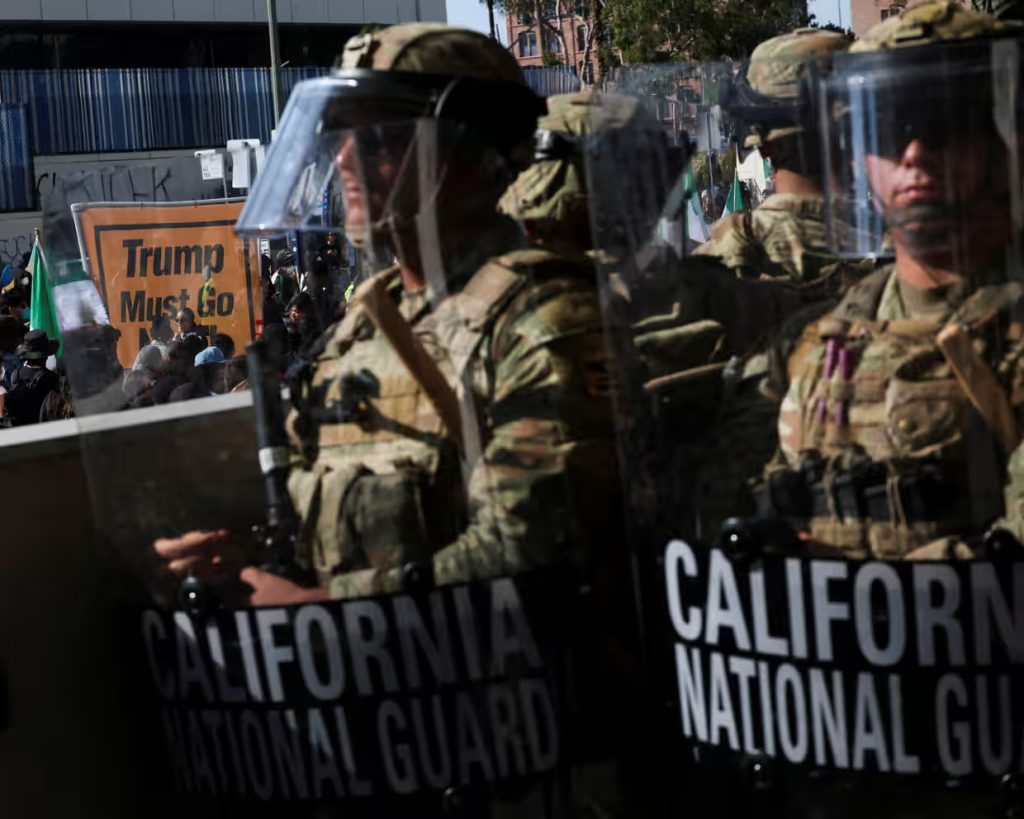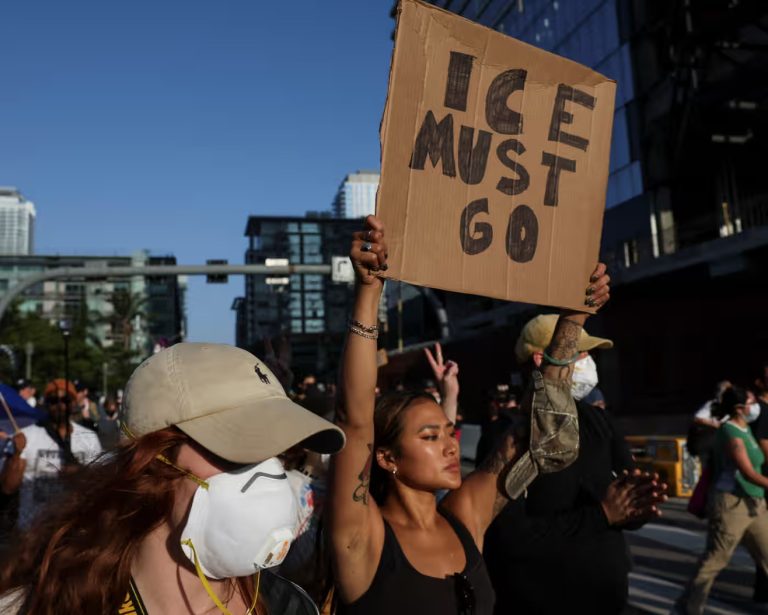The city of Los Angeles has imposed a curfew in part of downtown Tuesday night amid rising tensions between California and the Trump administration over immigration raids and the use of federal troops to respond to protests.
Mayor Karen Bass announced a 10-hour curfew, from 8 p.m. to 6 a.m., covering a one-square-mile area where protests against Immigration and Customs Enforcement (ICE) have continued. The LAPD reported over 300 arrests in the past two days. The move comes as Governor Gavin Newsom filed an emergency request to block Trump from deploying military forces alongside ICE agents in Los Angeles.
President Trump has ordered 4,000 National Guard troops and 700 Marines to the city following four days of unrest sparked by aggressive ICE operations targeting immigrant communities, including day laborers and garment workers.
In a lawsuit filed Monday, Newsom and California Attorney General Rob Bonta called Trump’s override of the state’s authority over the National Guard “unlawful.” A federal judge declined to issue an immediate ruling but set a hearing for Thursday.
Speaking Tuesday night, Newsom denounced Trump for “militarizing the streets” and “indiscriminately targeting hard-working immigrant families.” He described reports of ICE agents detaining a pregnant U.S. citizen, arresting people outside a Home Depot, and using unmarked cars to seize schoolchildren and laborers.
“That’s just weakness masquerading as strength,” Newsom said. “If some of us can be snatched from the streets based on suspicion or skin color, then none of us are safe.”
He urged the public to resist Trump’s actions: “What Donald Trump wants most is your silence, your complicity. Do not give it to him.”
Earlier Tuesday, Trump delivered a partisan speech at Fort Bragg in North Carolina, where he called LA protesters “animals” and vowed to “liberate Los Angeles.” He claimed without evidence that the protests were led by paid rioters carrying foreign flags and repeated a debunked conspiracy theory that bricks had been planted for protesters to throw at police.
That night, federal troops arrived in LA despite opposition from local leaders. Defense Secretary Pete Hegseth said the military presence could last 60 days and cost at least $134 million. Trump said the troops would remain until there was “no danger” and suggested he might invoke the Insurrection Act.
“Trump and Secretary Hegseth have brought military personnel and a ‘warrior culture’ into American cities,” California’s lawsuit stated. “Now they have turned their sights on California, with devastating consequences.”
Earlier that afternoon, downtown LA was largely calm aside from a heavily policed block near Little Tokyo, home to several federal buildings and the Metropolitan Detention Center. A small group of protesters and media gathered while National Guard troops leaned on riot shields and police cordoned off the area. One side of the block remained quiet; the other was surrounded by dozens of officers in riot gear.

A woman waving an upside-down American flag paced in front of the National Guard troops stationed in downtown Los Angeles, calling out to them to “make the right choice.” Her message was aimed at challenging their presence, though the Guard has not been directly involved in crowd control and is officially assigned to protect federal property.
The deployment of National Guard forces has drawn sharp opposition from California Democrats and every Democratic governor nationwide. Senator Alex Padilla told the Associated Press that the protests against Immigration and Customs Enforcement (ICE), and the resulting legal battle between California and the federal government, are “a crisis entirely of Trump’s making.”
“People are speaking up for basic rights and due process,” Padilla said, “but sending in the National Guard only adds fuel to the fire. This is exactly what Trump wants.”
Padilla also revealed that local law enforcement, including the Los Angeles County Sheriff’s Department, had not been informed ahead of the Guard’s federalization. “We’ve asked the Pentagon for clarity,” he said, “and apparently even the Department of Defense isn’t sure what the Guard’s mission is here.”
LA Police Chief Jim McDonnell emphasized that city and regional agencies have long-standing experience handling large protests. “We’re fully capable of managing the situation,” he said. “The uncoordinated arrival of federal forces complicates logistics and poses serious challenges for those of us tasked with protecting Los Angeles.”
In a statement Monday, U.S. Northern Command (Northcom) announced that Marines from the 2nd Battalion, 7th Marines of the 1st Marine Division would be deployed to work alongside existing forces protecting federal personnel and property in the greater LA area. Northcom added that troops had received training in de-escalation, rules of engagement, and crowd management. Around 1,700 troops from the California National Guard’s 79th Infantry Brigade Combat Team were already stationed in the region.
Meanwhile, Defense Secretary Pete Hegseth testified before the House Appropriations Subcommittee on Defense, originally convened to discuss the nearly $1 trillion 2026 defense budget. Lawmakers, however, quickly shifted focus to the controversial deployment of military forces to a U.S. city.
Representative Pete Aguilar of California pressed Hegseth on the military’s role in civilian law enforcement. “Why are you deploying warfighters into urban neighborhoods to engage with civilians?” he asked.
Hegseth defended the move, saying federal forces were responding to a “deteriorating situation” and were there to support law enforcement. “We’re here to keep the peace where Gavin Newsom has failed,” he said. “ICE agents are being attacked for doing their jobs — deporting illegal criminals. That shouldn’t happen in any city, whether it’s Minneapolis or Los Angeles. When that happens, it’s lawlessness.”

